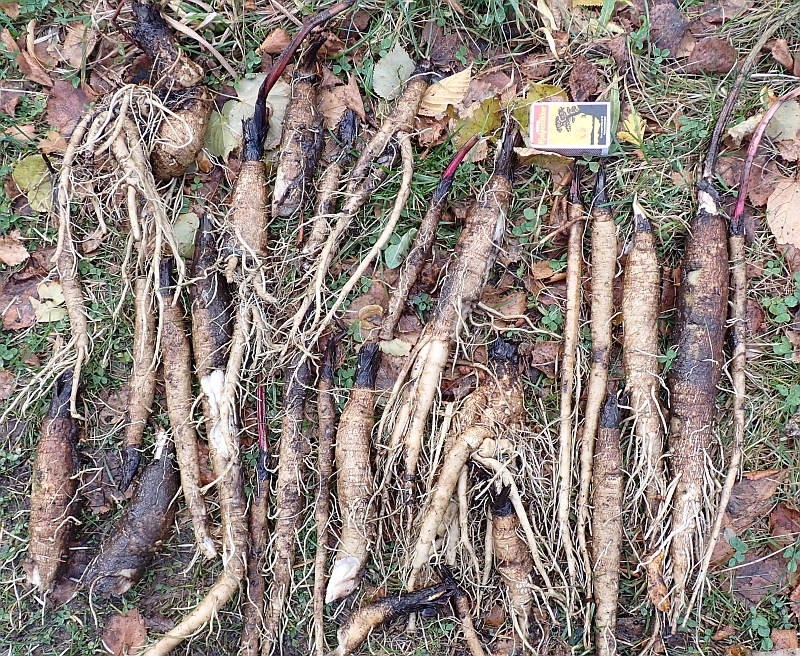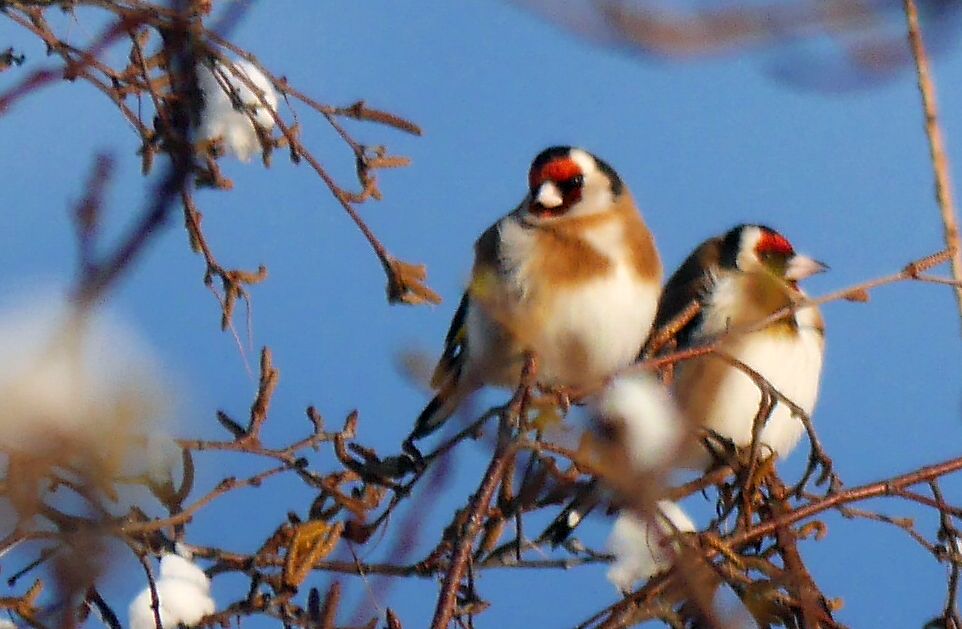Wonderful rain on the balcony (aka zone 0.5) with oca (Oxalis tuberosa), 9 varieties of lettuce (salat), tomato “42 days” , dill, coriander, toothache pant (Spilanthes), shungiku / kronkrage and lots of celery (around the corner). The large bucket in the corner contains burdock providing seed fot goldfinches (stillits) and greenfinches (grønnfink) in winter (a living bird feeder!)
Tag Archives: Greenfinch
Burdock harvest
I have a large bucket on the balcony where i grow greater burdock (Arctium lappa) for the birds, Both goldfinches (stillits) and greenfinches (grønnfink) eat burdock seed in winter and by growing the plants on the balcony I have close views of both species from where I’m typing this! Last year, the plants flowered and set seeds, they germinated en masse this spring, I thinned them and this was the harvest today. The largest roots and the smallest ones will be replanted in the spring. The others will be eaten in oriental stir-fries this winter.
See also other burdock posts: https://www.edimentals.com/blog/?s=arctium
The Birds
Over the last couple of days there’ve been large numbers of birds in the garden making me think of Alfred Hitchcock’s The Birds, although there have been fortunately no casualties as far as I know. I try to limit the amount of bird food I put out (as its production isn’t good for birds) and it’s good to see that most species are still eating natural food.
This winter there’ve been reports from all over the county of unusual numbers of overwintering bramblings (bjørkefink) with flocks up to 300 birds recorded. I’ve had smaller flocks of 20-30 for some time, but yesterday they were everywhere in the garden and at least 140 birds were present, a new winter record for Malvik kommune! The films below show them both at the bird feeder, feeding on rowan berries (eating the seed and discarding the flesh) and also on the ground perhaps feeding on birch seed?
Apart from that there was a sizeable flock of some 60 waxwings (sidensvans) on guelder rose / krossved (Viburnum opulus) and hawthorn (hagtorn) , 11 bullfinches (dompap), 50 house sparrows (gråspurv), 6 goldfinches (stillits) still mostly on burdock seed, 16 siskins (on birch seed), 6 greenfinches (grønnfink), 2 hawfinches (kjernebiter) seen on plum stones and rowan berries, a single robin (rødstrupe), a couple of fieldfares (gråtrost) on apples and hawthorn, a great spotted woodpecker (flaggspett) and great and blue tits both establishing territories now. In addition, a flock of 500-600 jackdaws (kaie) fly over to the roost every evening.
Bramblings with a hawfinch:
Bramblings with a hawfinch feeding on rowan seed (at the end, both birds are seen to discard the flesh). A greenfinch was also feeding on rowan.
Bramblings on the ground (feeding on birch seed?)
Large flock of bramblings at the bird feeder:
A Charm of Goldfinches
With heavy wet snow overnight weighing down all the plants in the garden together with plummeting air temperature, a flock of goldfinches (stillits) (collectively known as a Charm) were at the bird feeder this morning. I guess it’s more difficult for goldfinches to get at their preferred food, burdock seed (Arctium spp.) in these conditions.
With bramblings (bjørkefink), greenfinch (grønnfink) and yellowhammers (gulspurv).



Burdock for goldfinches
I’ve written a series of articles in 3 parts “Fuglevennlige planter i hagen” (Bird friendly plants in the garden) for the magazine of our national bird society (NOF, now Birdlife Norge) called Vår Fuglefauna (Our Bird Fauna). The first part (6 pages) has already been published (the first two pages are shown below; deliberately blurred text (below).
My most successful plant (genus) supplying bird food in winter has been various species of burdock / borre (Arctium spp.). The oil rich seeds are very popular with goldfinches (stillits) and greenfinches (grønnfink). This autumn I cut a few plants growing in a different part of the garden and moved them in full view of my kitchen window which allowed me to film a flock of 11 goldfinches yesterday (see below). In the summer, the same plants are popular with various pollinators and for that reason also provide food for other insectivorous birds in summer.

The article will also be published for members of Norwegian Seed Savers’ guild for “Insect and Bird Friendly Plants” in a few months from now. This guild works focuses on plants that are beneficial for maintaining a garden rich in a diversity of insects and birds, whilst still providing food for us!
Is feeding birds a good thing?

Feeding birds in winter isn’t necessarily a good thing and at least one study has shown that birds lay lower numbers of eggs when fed well, perhaps due to an unnatural unbalanced oil-rich diet: https://blog.nature.org/science/2015/01/05/winter-bird-feeding-good-or-bad-for-birds
However, there are many studies showing the opposite. But is good winter survival and artificially high populations necessarily a good thing apart from entertaining us and increasing awareness of the natural world.
Then there’s the spread of disease at bird feeders as with the greenfinch (grønnfink) in the UK (populations plummeted and bird feeders no doubt contributed to the spread). That birds are discouraged from migrating and stay in the same area year round can also lead to greater exposure to disease.
But what about the production of bird food? That happens often in large fields, mostly using conventional BigAg non-organic systems which directly impacts local bird populations by pesticides and habitat loss. Here in Norway, little of the bird feed is grown in-country.
For these reasons, I try as far as possible to provide natural food for the birds so that they can find alternatives and I can delay putting out food as long as possible. Home grown apples are put out for the thrushes, I tidy seed heads in spring and nettle seeds loved by finches are allowed to hang all winter. Local grain can also be put out for yellowhammers (gulspurv).
In the case of goldfinches (stillits), their main food is burdock (borre) and I have introduced Arctium lappa (greater burdock / storborre) to my garden for them and greenfinches (grønnfink). However, at this time of year they tend to move over to the birdfeeder.
Here’s a couple of videos from the weekend of these beautiful birds that once were rare in this part of Norway, but are becoming more common each year. See other goldfinch posts here: https://www.edimentals.com/blog/?s=goldfinch
Greenfinch on burdock
Goldfinch flock returns
1) …with Yellowhammers (gulspurv), tree sparrows (pilfink) and house sparrow (gråspurv)
2) ……with greenfinch and yellowhammers (grønnfink og gulspurv)
3) …with a nuthatch doing neck exercises (taken from a film)

Greenfinches sunbathing
Greenfinches (grønnfink) enjoying the sunshine in the garden with a few yellowhamers (gulspurv) amongst the aspen (osp) buds!
